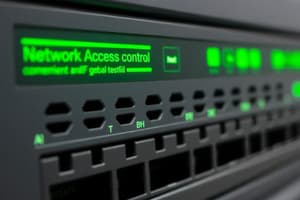Podcast
Questions and Answers
What type of access control mechanism does UNIX use for managing file permissions?
What type of access control mechanism does UNIX use for managing file permissions?
- Discretionary Access Control (DAC)
- Role Based Access Control (RBAC)
- Mandatory Access Control (MAC)
- Access Control Lists (ACLs) (correct)
What does the 'rwx' permission indicate for the user Zakir on his directories?
What does the 'rwx' permission indicate for the user Zakir on his directories?
- Read only
- Write only
- Read, write, and execute (correct)
- No permissions
What is the result when a user accesses an object in UNIX?
What is the result when a user accesses an object in UNIX?
- It bypasses ACL checks
- Access is automatically granted
- It is checked against the user's permissions (correct)
- Only root can access all objects
What is indicated by the permission letters 'r--' for the user on test.py?
What is indicated by the permission letters 'r--' for the user on test.py?
Who can change file ownership in a UNIX system?
Who can change file ownership in a UNIX system?
What is the significance of UID 0 in UNIX systems?
What is the significance of UID 0 in UNIX systems?
Which operation can the owner of a file perform in UNIX regarding permissions?
Which operation can the owner of a file perform in UNIX regarding permissions?
Which of the following correctly describes access control in UNIX systems?
Which of the following correctly describes access control in UNIX systems?
How does UNIX handle file ownership?
How does UNIX handle file ownership?
What is the purpose of groups in UNIX systems?
What is the purpose of groups in UNIX systems?
What does the 'Read' permission allow a user to do with a file?
What does the 'Read' permission allow a user to do with a file?
What is a service account in UNIX?
What is a service account in UNIX?
In UNIX, how can a user check the users on their system?
In UNIX, how can a user check the users on their system?
Which statement about the least privilege principle is true?
Which statement about the least privilege principle is true?
What is a potential risk associated with the UNIX security model regarding root access?
What is a potential risk associated with the UNIX security model regarding root access?
Which statement accurately describes the shortcomings of Access Control Lists (ACLs) in UNIX?
Which statement accurately describes the shortcomings of Access Control Lists (ACLs) in UNIX?
What does a security descriptor in the Windows security model contain?
What does a security descriptor in the Windows security model contain?
What is one advantage of the Windows security model compared to the UNIX security model?
What is one advantage of the Windows security model compared to the UNIX security model?
How do groups function in UNIX systems regarding user permissions?
How do groups function in UNIX systems regarding user permissions?
What information is typically included in a process's access token in Windows?
What information is typically included in a process's access token in Windows?
Which of the following best describes the disparity in the management of objects between UNIX and Windows systems?
Which of the following best describes the disparity in the management of objects between UNIX and Windows systems?
What is a major limitation of UNIX's file ownership and permission system?
What is a major limitation of UNIX's file ownership and permission system?
Flashcards
Access Control
Access Control
Mechanism for controlling who can access resources (files, directories, etc.) and what they can do with them.
ACL (Access Control List)
ACL (Access Control List)
A list specifying who can access an object and what they can do.
RBAC (Role-Based Access Control)
RBAC (Role-Based Access Control)
Access control based on assigned roles, not individual users.
Security Policies
Security Policies
Signup and view all the flashcards
UNIX Security Model
UNIX Security Model
Signup and view all the flashcards
Subject (Security)
Subject (Security)
Signup and view all the flashcards
Object (Security)
Object (Security)
Signup and view all the flashcards
Operation (Security)
Operation (Security)
Signup and view all the flashcards
User ID (UID)
User ID (UID)
Signup and view all the flashcards
Root User
Root User
Signup and view all the flashcards
Groups
Groups
Signup and view all the flashcards
Group ID (GID)
Group ID (GID)
Signup and view all the flashcards
File Ownership
File Ownership
Signup and view all the flashcards
Least Privilege
Least Privilege
Signup and view all the flashcards
Windows Security Model
Windows Security Model
Signup and view all the flashcards
Security Descriptor (Windows)
Security Descriptor (Windows)
Signup and view all the flashcards
Tokens (Security)
Tokens (Security)
Signup and view all the flashcards
Access Request
Access Request
Signup and view all the flashcards
Access Control- Pros
Access Control- Pros
Signup and view all the flashcards
Access Control- Cons
Access Control- Cons
Signup and view all the flashcards
Study Notes
Access Control Example 1
- Drew who is a member of cs155-tas has access to the "homework" directory, as Drew's group "cs155-tas" has rwx (read, write, execute) permissions.
Access Control Example 2
- Students can access the "lectures" directory as students likely have access to the server and the lectures directory has r-x (read, execute) permissions for the "cs155-tas" group.
Access Control Lists (ACLs)
- Every object has an ACL, which defines what operations subjects can perform.
- Each access to an object is checked against the object's ACL.
Role Based Access Control (RBAC)
- Access control matrices can become complex as the number of subjects, objects, and operations increase.
- Users should only be able to access the data and resources needed to perform authorized tasks (least privilege principle).
Security Policies
- Subjects (who?): Acting system principals (e.g., user, app, process)
- Objects (what?): Protected resources (e.g., memory, files, hardware devices).
- Operations (how?): How subjects operate on objects (e.g., read, delete).
UNIX Security Model
- Subjects: Users and processes.
- Objects: Files, directories, sockets, pipes, hardware devices, kernel objects, process data.
- Access Operations: Read, write, execute.
Users
- Every user has a unique user ID (UID).
- UID 0 is reserved for the "root" user, which has access to everything.
Example Users
- Users can be viewed through /etc/passwd file.
- Users can have various roles, such as service accounts for background processes or user accounts for specific humans.
Groups
- Groups are collections of users that share files and system resources.
- Every group has a group ID (GID) and name.
File Ownership
- All Linux resources are managed as files.
- Each file or directory has a single user owner and group owner.
Access Control
- Subjects have access to a file: user owner, group owner, and others.
- Permissions exist for each subject for read, write, and execute operations.
- Owner can change permissions and group.
Access Control - Pros and Cons
- Pros:
- Simple model provides protection for most situations.
- Flexible enough to make simple systems possible.
- Cons:
- ACLs are coarse-grained, making it difficult to handle complex enterprise scenarios.
- ACLs do not handle different applications within a single user account.
- Nearly all system operations require root access.
Windows Security Model
- Windows employs a complex system for granting access.
- Windows has flexible access control options.
- Objects have full ACLs, enabling fine-grained permissions.
- Users can belong to multiple nested groups.
Object Security Descriptors
- Windows's objects have a security descriptor.
- The security descriptor specifies who can perform what and audit rules.
- Security descriptors contain SIDs, DACLs, and SACLs.
Tokens
- Each process has a set of security tokens, which contain the process's security context.
- Impersonation tokens can be used to temporarily adopt a different context.
Access Request
- When a process tries to access an object, it presents its security tokens to the object's security descriptor.
- Access is granted based on the object's security descriptor and the process's security tokens, allowing or denying the access request.
Studying That Suits You
Use AI to generate personalized quizzes and flashcards to suit your learning preferences.




